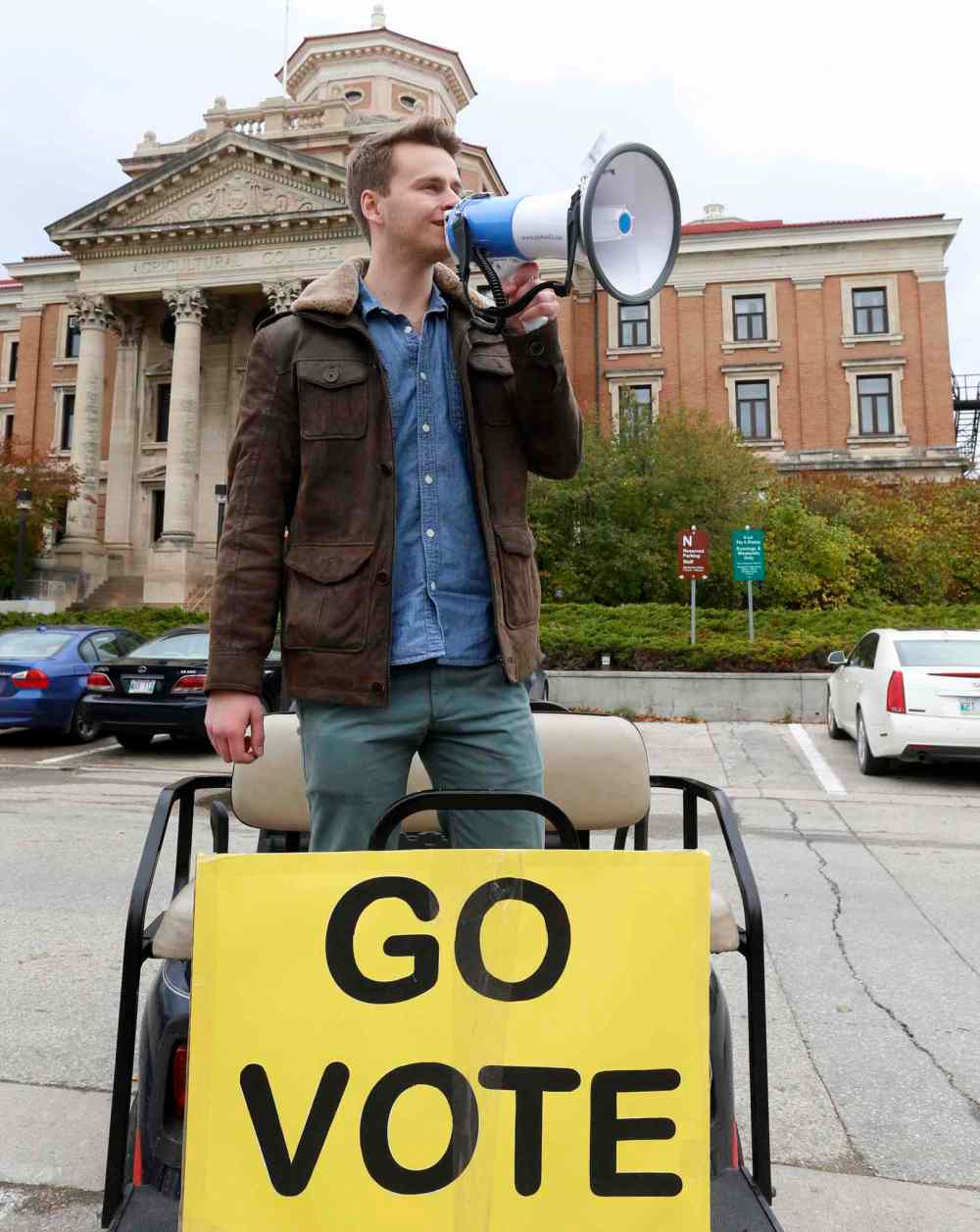Every vote matters, even if you’re new at voting
Youth turnout key way to effect change in elections
Advertisement
Read this article for free:
or
Already have an account? Log in here »
To continue reading, please subscribe:
Monthly Digital Subscription
$0 for the first 4 weeks*
- Enjoy unlimited reading on winnipegfreepress.com
- Read the E-Edition, our digital replica newspaper
- Access News Break, our award-winning app
- Play interactive puzzles
*No charge for 4 weeks then price increases to the regular rate of $19.00 plus GST every four weeks. Offer available to new and qualified returning subscribers only. Cancel any time.
Monthly Digital Subscription
$4.75/week*
- Enjoy unlimited reading on winnipegfreepress.com
- Read the E-Edition, our digital replica newspaper
- Access News Break, our award-winning app
- Play interactive puzzles
*Billed as $19 plus GST every four weeks. Cancel any time.
To continue reading, please subscribe:
Add Free Press access to your Brandon Sun subscription for only an additional
$1 for the first 4 weeks*
*Your next subscription payment will increase by $1.00 and you will be charged $16.99 plus GST for four weeks. After four weeks, your payment will increase to $23.99 plus GST every four weeks.
Read unlimited articles for free today:
or
Already have an account? Log in here »
Hey there, time traveller!
This article was published 08/10/2015 (3714 days ago), so information in it may no longer be current.
In some ways, the Canadian political climate in 2015 feels similar to that of the United States in 2008 — on the left, at least. That sense of fatigue. That yearning for change.
After eight years of George Dubya Bush, Americans elected a new leader in Barack Obama. For a great many Canadians, nine years of Stephen Harper has been enough — or too much, if you ask people who are concerned about such issues as, say, the climate. Strategic voting campaigns such as Anyone But Harper are gaining traction, particularly on social media. It feels as though a fire has been lit.
For a significant change on Parliament Hill to happen, many are looking to the elusive but potentially powerful 18 to 24 demographic — the so-called “youth vote.” Fewer than 32 per cent of Manitobans between the ages of 18 and 24 voted in the 2011 election, according to Elections Canada. The national average was 38.8 per cent.

The youth vote could be a game-changer in this election. But there are many reasons why young people don’t vote, and they aren’t just limited to apathy — although there’s that, too. In a CBC interview that’s making the rounds, comedian Rick Mercer floated a very simple theory: they don’t know how.
“They’ve never voted. They’re intimidated by the process. Their parents never took them to vote,” he said.
Salient points. Indeed, if you’ve never voted before, there’s an aura of mystery about it. It seems complicated and time-consuming. And people generally don’t love admitting they are clueless about something everyone else seems to be in on. “Oh my God, are you serious, Youthful-Sounding Name? You don’t know how to vote? You are an embarrassment to democracy.”
Don’t worry. Here’s how it’ll go down.
1. If you received a brown voter information card in the mail, great, you’re all set. Proceed to step 3.
2. If you didn’t get a voter registration card, you must register at elections.ca or by calling 1-800-463-6868. If you don’t have a driver’s licence or provincial or territorial ID card, you’ll need two pieces of ID and one must have your current address on it. If you don’t have any ID with an address, you must take an oath. Someone has to vouch for who you are, essentially, and that someone has to be registered in the same polling division. (Gee, I can’t imagine why anyone finds this process confusing.)
3. Then you’ll go down to your polling station — which is often an elementary school gymnasium — and some earnest student will show you where to go. You’ll fill out a ballot, selecting the candidate you feel will best represent your constituency in Parliament. Your ballot is put in a box, and that 10-year-old will cheerily thank you for voting on your way out. Congratulations: you participated in our democratic process. Easy, right? Eh…
In an ideal world, everyone would do their homework and vote for the candidate/party that best aligns with their values and what they’d like to see for Canada. But thanks to the way our electoral system is set up, some candidates have little to no chance of winning, thanks to vote-splitting. That’s where strategic voting comes into play — or the idea of voting against someone as opposed to voting for someone.
We love to tell young people their vote matters. Strategic voting sends the message it doesn’t — at least not mathematically — unless you’re voting ABC (Anyone But Conservative). But what if your goal isn’t “Anyone But Harper”? What if you, plucky idealist, want to vote for the candidate you most believe in? Strategic voting also sends the message local candidates don’t matter. We’ve all heard it before: “Gee, I’d really like to vote for X, but X will never win, so I’m voting Y.”
Writing for Rabble, Karl Nerenberg suggests an emphasis on voter turnout, rather than strategy, will achieve the same goal. “If ‘unlikely voters’ — such as the young, the poor, and indigenous Canadians — voted in proportion to their population, there would be very little chance the current prime minister could get anywhere near another majority.”
This week, the University of Manitoba has been doing its part to increase young voter turnout. The University of Manitoba Students’ Union has been picking up students in golf carts and driving them to the Pembina Hall Student Lounge, where an Elections Canada office was set up as part of a pilot project to make voting more accessible to young people. As of Thursday morning, 500 students cast their ballots. It’s a start.
UMSU president Jeremiah Kopp points out one of the reasons young people don’t engage with politics is because politicians often don’t engage with them. He says leaders who do well “respect and connect” with their young voters. He points to Obama as an example of a candidate who was able to tap into the youth vote by speaking to young people on their level — which is about much more than maintaining an awesome Twitter presence. It’s about discussing the issues that matter to young people in a meaningful way.
And that’s perhaps the most important difference between America circa 2008 and Canada circa 2015: there’s no one candidate that has truly captured the imaginations of this country’s youth. There’s an urgency about this election, but there’s little excitement.
Electoral reform could go a long way in the fight against what’s-the-point apathy among young voters. But candidates could also do more to actually earn their votes.

Jen Zoratti is a columnist and feature writer working in the Arts & Life department, as well as the author of the weekly newsletter NEXT. A National Newspaper Award finalist for arts and entertainment writing, Jen is a graduate of the Creative Communications program at RRC Polytech and was a music writer before joining the Free Press in 2013. Read more about Jen.
Every piece of reporting Jen produces is reviewed by an editing team before it is posted online or published in print – part of the Free Press‘s tradition, since 1872, of producing reliable independent journalism. Read more about Free Press’s history and mandate, and learn how our newsroom operates.
Our newsroom depends on a growing audience of readers to power our journalism. If you are not a paid reader, please consider becoming a subscriber.
Our newsroom depends on its audience of readers to power our journalism. Thank you for your support.
















